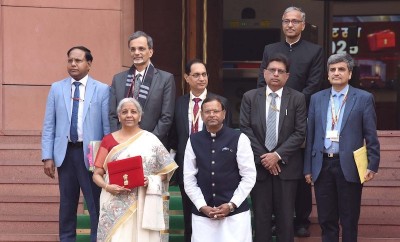
India’s growth outlook dims after US tariffs; deeper rate cuts likely, say analysts: Report
New Delhi: India’s economic growth in the current financial year could dip by 20 to 40 basis points following fresh tariffs imposed by the United States, potentially prompting the Reserve Bank of India (RBI) to take a more aggressive stance on rate cuts, Reuters reported, citing economists.
On Wednesday, U.S. President Donald Trump announced a 26% reciprocal tariff on Indian goods, putting pressure on the RBI’s 6.7% GDP growth forecast for 2025-26, as well as the government's economic survey projection of 6.3% to 6.8%.
In response to the tariff move, Goldman Sachs revised its growth projection downward to 6.1% from 6.3%.
Citi projected a direct and indirect impact of 40 basis points on growth, while QuantEco Research pegged the likely hit at 30 basis points.
With inflation projected to average 4.2% this year — close to the central bank’s target — the RBI delivered its first rate cut in five years in February.
Another 25 bps cut is expected at the upcoming April 7–9 policy meeting, according to a Reuters poll.
While the poll earlier suggested only one more cut after that — bringing the repo rate to 5.75% by August before a pause — the latest U.S. trade measures have led analysts to revisit their forecasts.
Goldman Sachs, Citi, and QuantEco Research now expect a total of 75 bps in rate cuts this financial year, which would lower the benchmark rate to 5.5% — the lowest since August 2022.
"This would be an appropriate risk minimization strategy on the face of larger downside risks to growth compared to much lower upside risk to inflation," Citi India chief economist Samiran Chakraborty wrote in a note late Thursday, according to the Reuters report.
In its February policy statement, the RBI’s monetary policy committee had said the current growth-inflation equation "opens up policy space… to support growth, while remaining focussed on aligning inflation with the target."
Growth is estimated to have slipped to a four-year low of 6.5% in FY2024 due to weakening urban demand, high inflation, tighter liquidity, and more restrictive lending norms that slowed personal loan and credit card growth.
Since taking charge in December, RBI Governor Sanjay Malhotra has moved to ease liquidity conditions. Proposed tightening of banking rules has also been deferred.
The government’s February budget included tax relief for those earning up to ₹1.2 million a year, which is expected to support household consumption.
A government official, who did not wish to be named, said the combination of tax relief and lower interest rates would provide a cushion to domestic demand.
While a broad stimulus is not being considered at this time, targeted measures may be used to address sector-specific challenges.
"Rewriting of trade rules would prompt policymakers globally to take a hard look at reviving domestic consumption and demand," said Vivek Kumar, economist at QuantEco Research. For India, he added, this could involve further rate cuts and a weaker rupee.
Support Our Journalism
We cannot do without you.. your contribution supports unbiased journalism
IBNS is not driven by any ism- not wokeism, not racism, not skewed secularism, not hyper right-wing or left liberal ideals, nor by any hardline religious beliefs or hyper nationalism. We want to serve you good old objective news, as they are. We do not judge or preach. We let people decide for themselves. We only try to present factual and well-sourced news.







